Charles E W Bean, Diaries, AWM38 3DRL 606/276/1 - 1928-1937 - Part 6

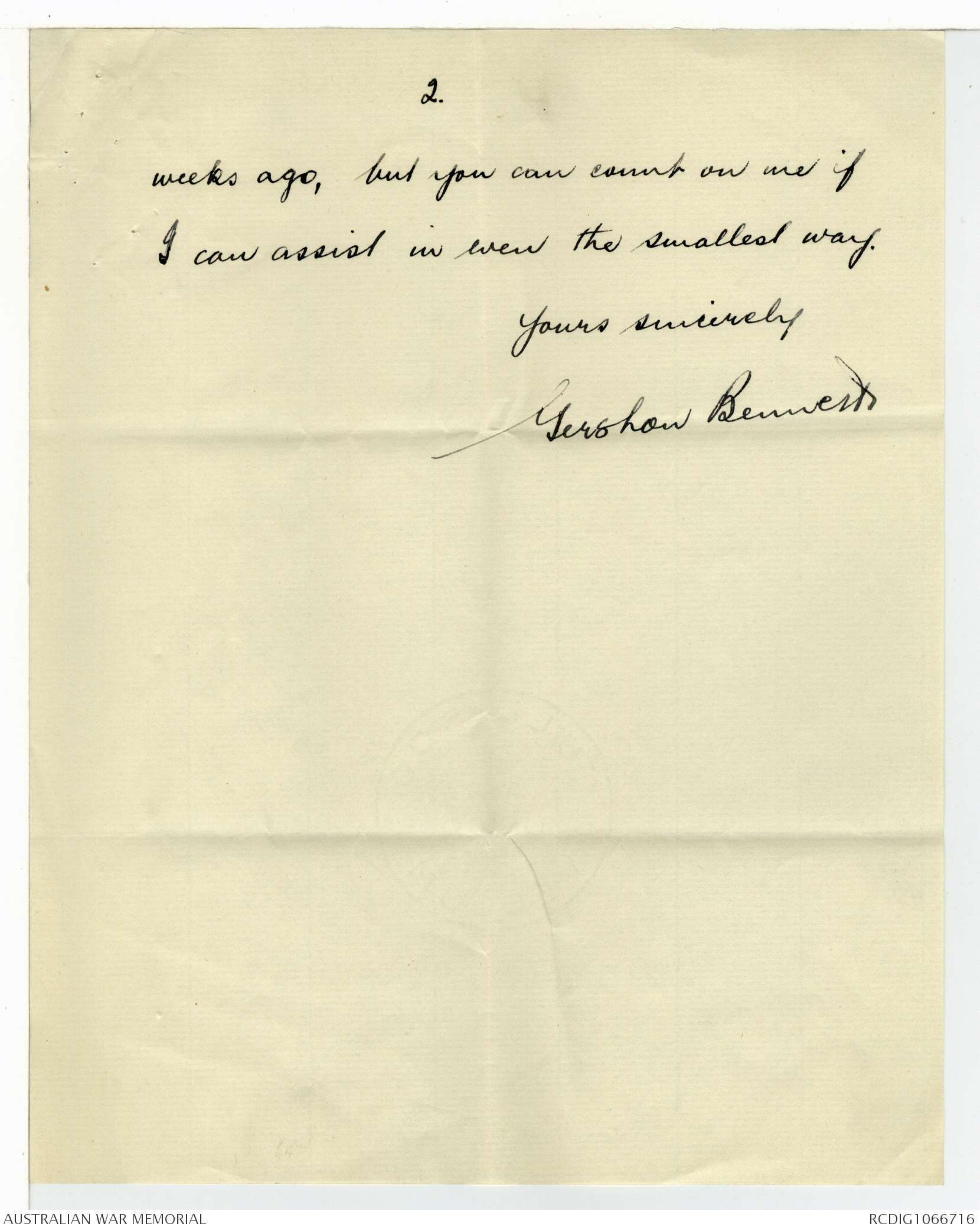
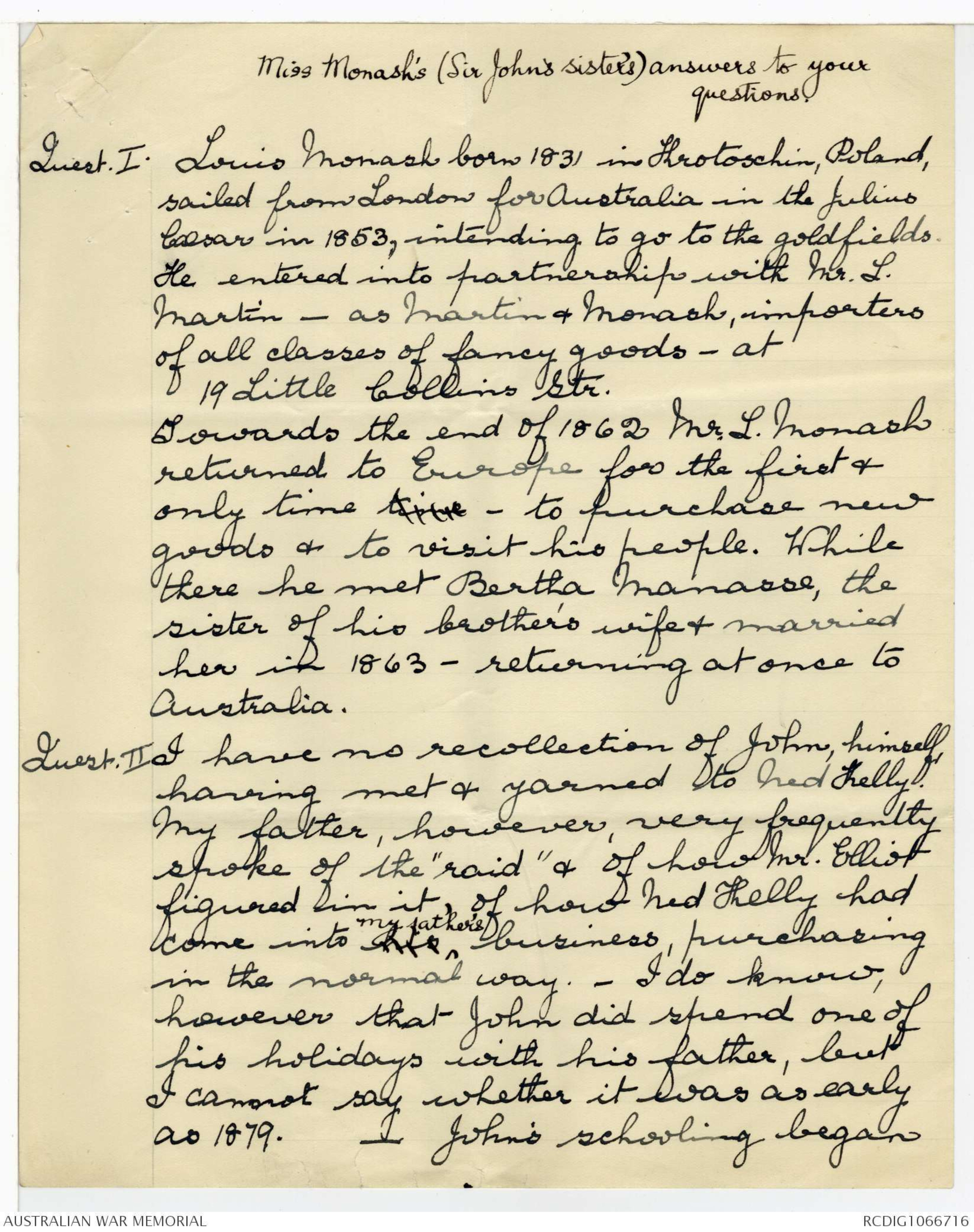
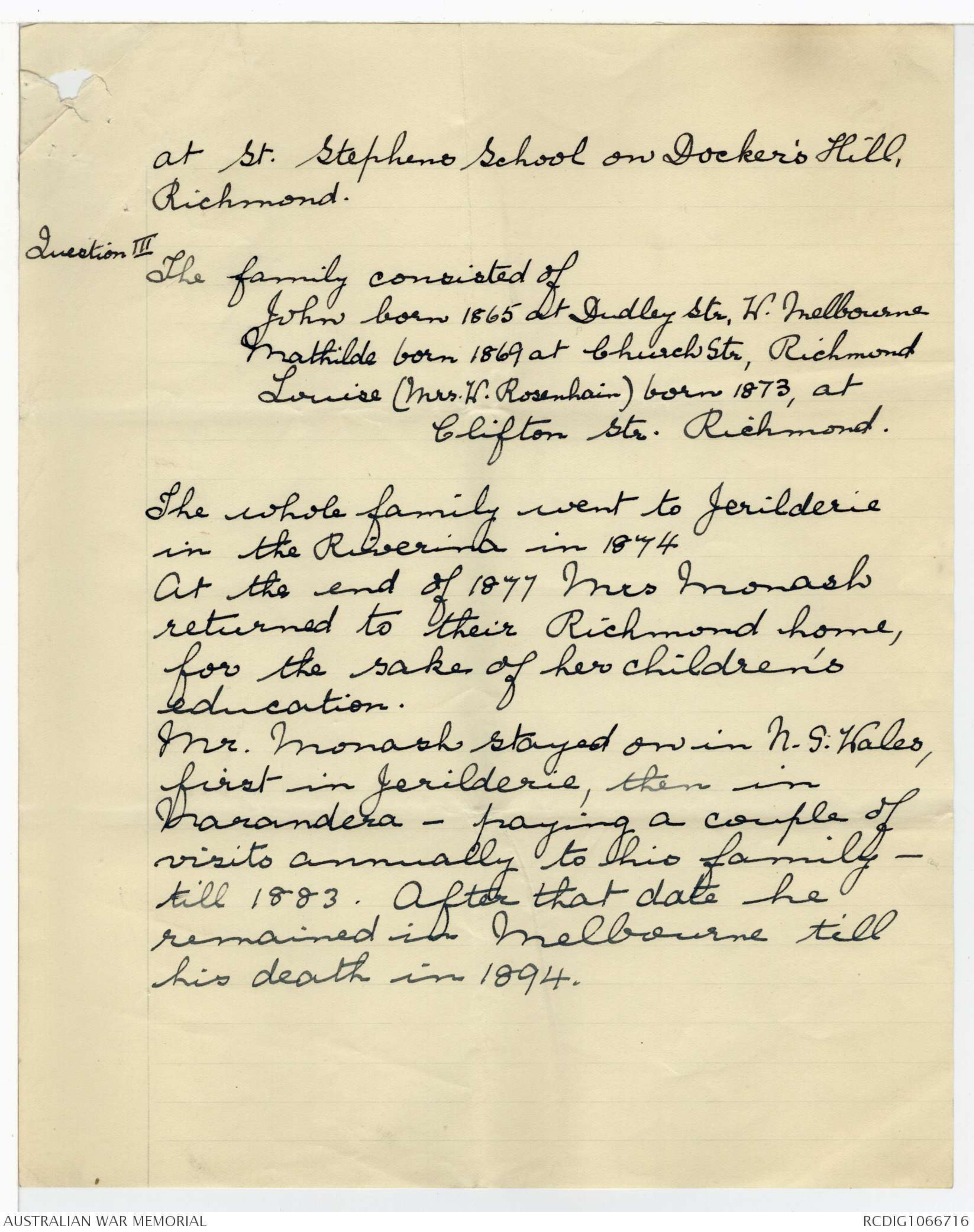
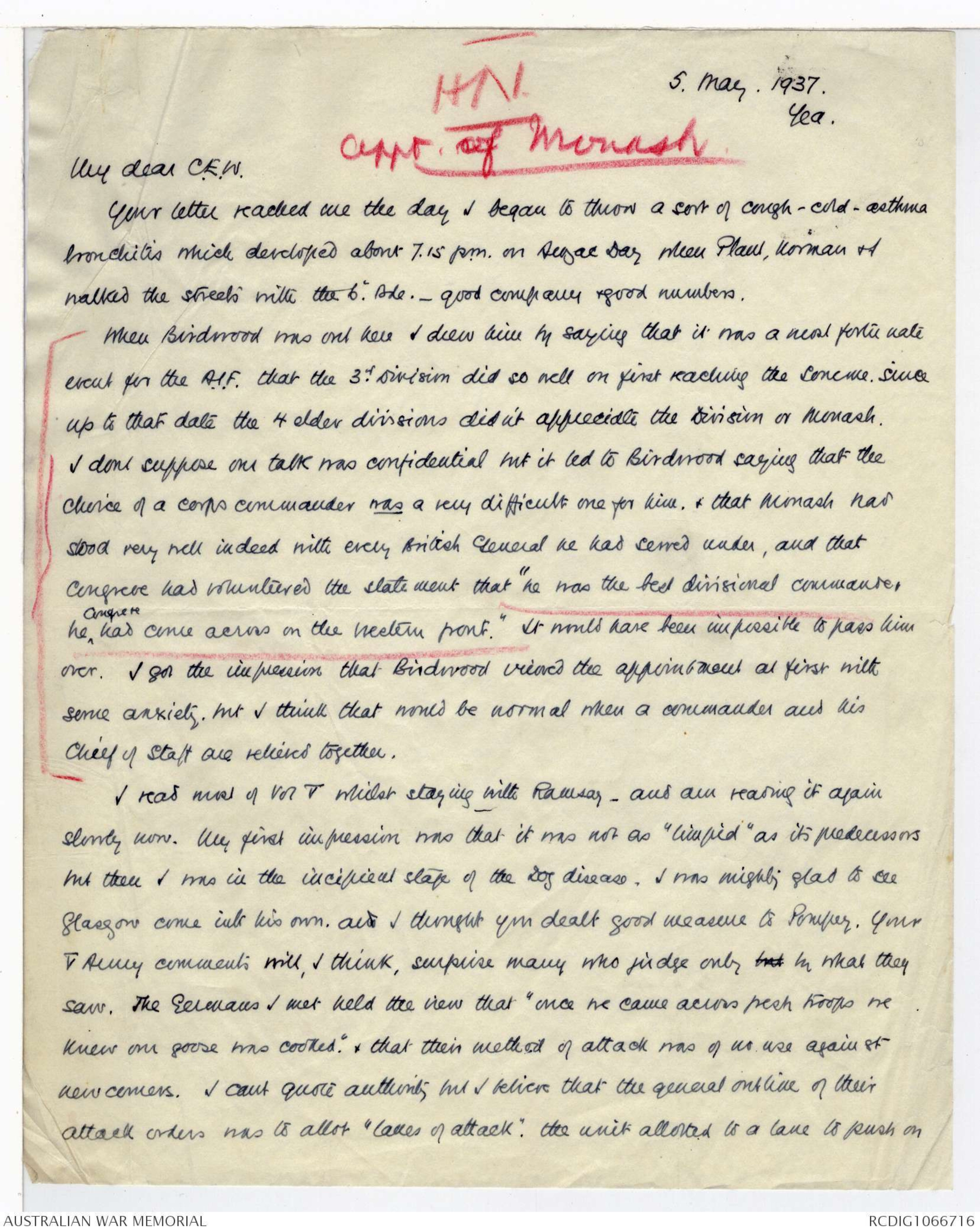
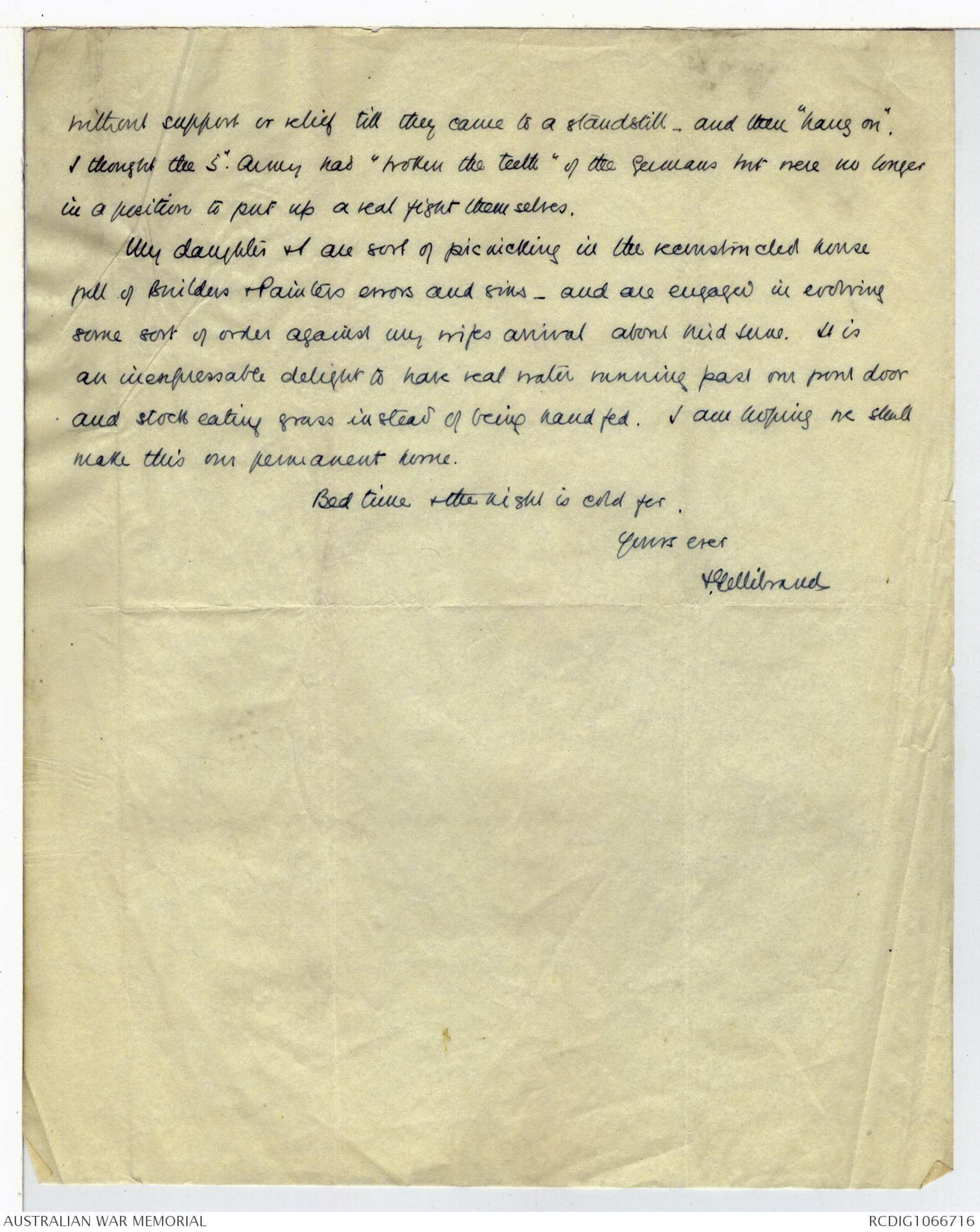
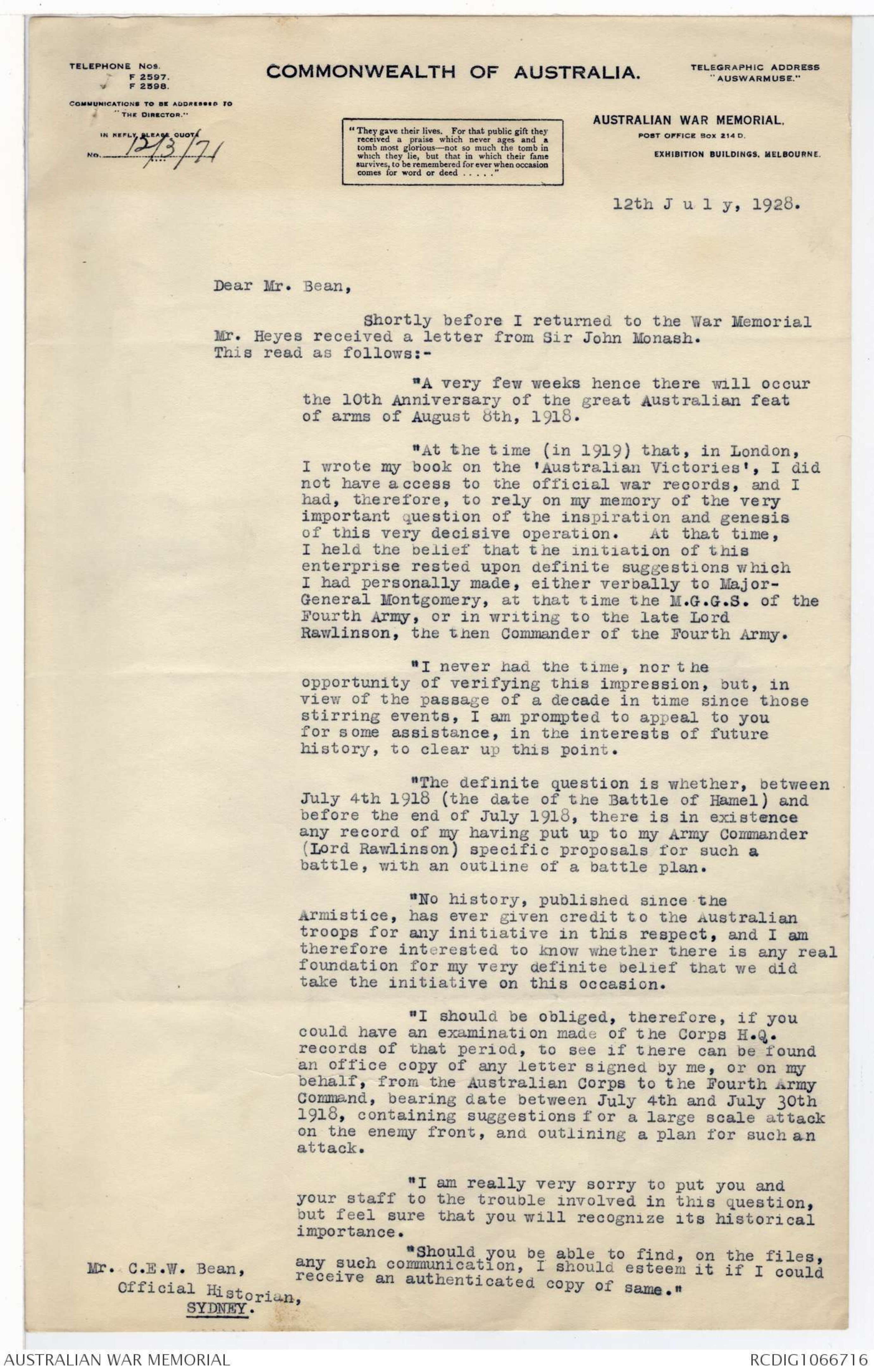

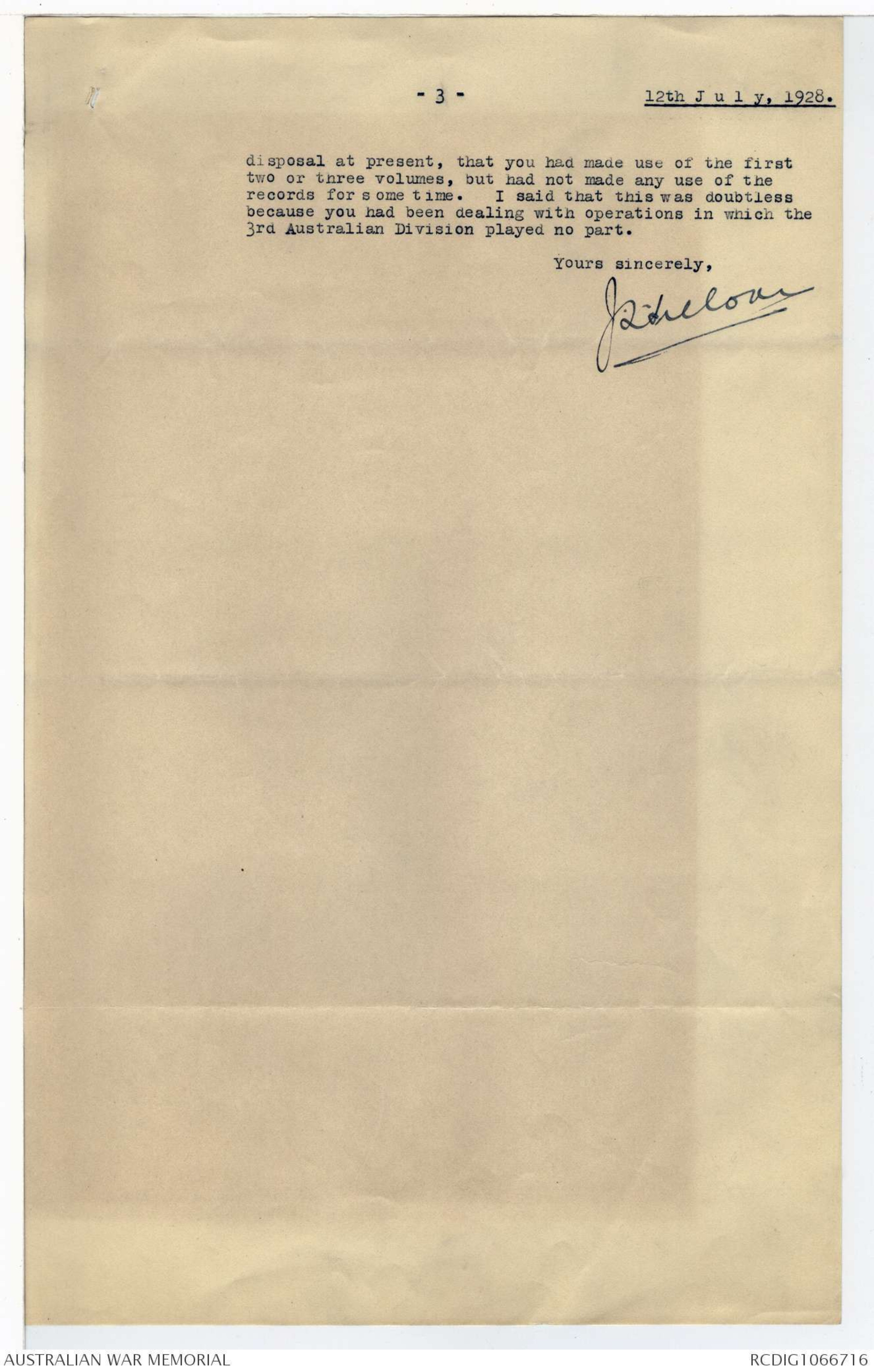
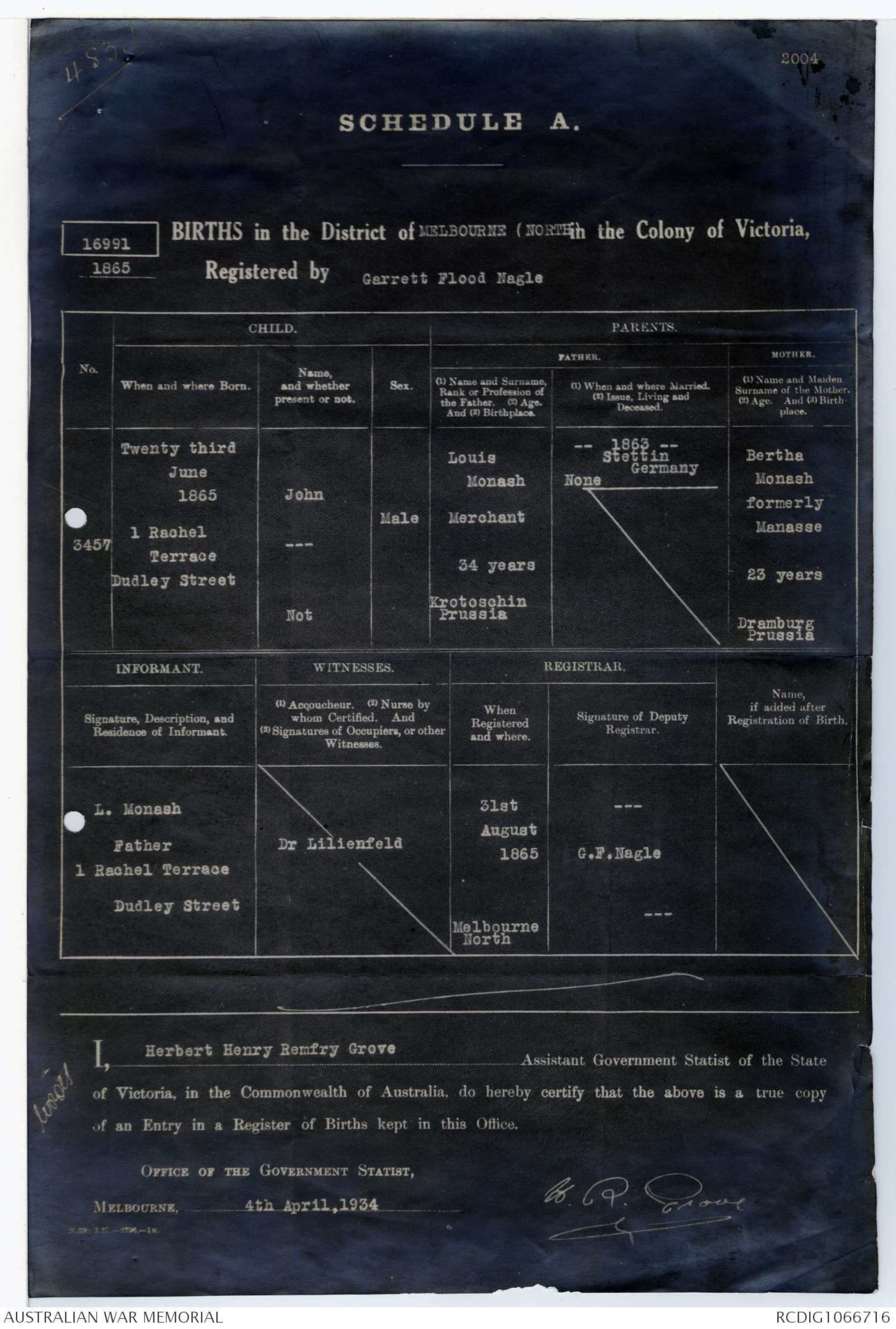
"IONA."
ST. GEORGE'S ROAD.
TOORAK. S.E.2.
Aug 28th 1937.
H.N.
John Monash.
Dear Dr Bean,
I am glad to have an
opportunity of being of service to you; and
I deeply appreciate your kindly remarks
on my address to the Jewish Graduates
on the life of Sir John. I would like to
state in answer to your note re intrusion
upon the family privacy, that the family
welcome all your inquiries and will be
delighted to answer them. I must apologise
for my tardy answer to your letter but I
had to consult Sir John's sister (Miss M.
Monash) with reference to your questions. I
enclose her answers. I regret that I did not
call on you when I was in Sydney a few
2.
weeks ago, but you can count on me if
I can assist in even the smallest way.
Yours sincerely
Gershon Bennett.
Miss Monash's (Sir John's sister's) answers to your
questions.
Quest. I. Louis Monash born 1831 in Throtoschin, Poland,
sailed from London for Australia in the Julius
Caesar in 1853, intending to go to the goldfields.
He entered into partnership with Mr. L.
Martin - as Martin & Monash, importers
of all classes of fancy goods - at
19 Little Collins Str.
Towards the end of 1862 Mr. L. Monash
returned to Europe for the first &
only time time - to purchase new
goods & to visit his people. While
there he met Bertha Manasse, the
sister of his brother's wife & married
her in 1863 - returning at once to
Australia.
Quest. II I have no recollection of John, himself
having met & yarned to Ned Kelly.
My father, however, very frequently
spoke of the "raid" & of how Mr. Elliot
figured in it, of how Ned Kelly had
come into his ^my father's business, purchasing
in the normal way. - I do know,
however that John did spend one of
his holidays with his father, but
I cannot say whether it was as early
as 1879. - John's schooling began
at St. Stephens School on Docker's Hill,
Richmond.
Question III The family consisted of
John born 1865 at Dudley Str, W. Melbourne
Mathilde born 1869 at Church Str, Richmond
Louise (Mrs. H. Rosenhain) born 1873, at
Clifton Str. Richmond.
The whole family went to Jerilderie
in the Riverina in 1874
At the end of 1877 Mrs Monash
returned to their Richmond home,
for the sake of her children's
education.
Mr. Monash stayed on in N. S. Wales,
first in Jerilderie, then in
Narandera - paying a couple of
visits annually to his family -
till 1883. After that date he
remained in Melbourne till
his death in 1894.
5. May. 1937.
Yea.
HN.
Appt. of Monash
My dear C.E.W.
Your letter reached me the day I began to throw a sort of cough-cold-asthma
bronchitis which developed about 7.15 p.m. on Anzac Day when Plant, Norman & I
walked the streets with the 6th Bde. - good company & good numbers.
When Birdwood was out here I drew him by saying that it was a most fortunate
event for the A.I.F. that the 3rd Division did so well on first reaching the Somme. since
up to that date the 4 older divisions didn't appreciate the Division or Monash.
I dont suppose our talk was confidential but it led to Birdwood saying that the
choice of a corps commander was a very difficult one for him, & that Monash had
stood very well indeed with every British General he had served under, and that
Congreve had volunteered the statement that "he was the best divisional commander
he ^Congreve had come across on the Western front." It would have been impossible to pass him
over. I got the impression that Birdwood viewed the appointment at first with
some anxiety, but I think that would be normal when a commander and his
Chief of Staff are relieved together.
I read most of Vol V whilst staying with Ramsay - and am reading it again
slowly now. My first impression was that it was not as "limpid" as its predecessors
but then I was in the incipient stage of the dog disease. I was mighty glad to see
Glasgow come into his own. and I thought you dealt good measure to Pompey. Your
V Army comments will, I think, surprise many who judge only but by what they
saw. The Germans I met held the view that "once we came across fresh troops we
knew our goose was cooked." & that their method of attack was of no use against
newcomers. I cant quote authority but I believe that the general outline of their
attack orders was to allot "lanes of attack". the unit allotted to a lane to push on
without support or relief till they came to a standstill, and then "hang on."
I thought the 3rd. Army has "broken the teeth" of the Germans but were no longer
in a position to put up a real fight themselves.
My daughter & I are sort of picnicking in the reconstructed house
full of Builders & Painters errors and sins - and are engaged in evolving
some sort of order against my wifes arrival about mid June. It is
an inexpressable delight to have real water running past our front door
and stock eating grass instead of being hand fed. I am hoping we shall
make this our permanent home.
Bed time & the night is cold for
Yours ever
J.Gellibrand
TELEPHONE NOS.
F 2597.
F 2598.
COMMUNICATONS TO BE ADDRESSED TO
"THE DIRECTOR."
IN REPLY PLEASE QUOTE
NO. 12/3/71
COMMONWEALTH OF AUSTRALIA.
TELEGRAPHIC ADDRESS
"AUSWARMUSE."
AUSTRALIAN WAR MEMORIAL.
POST OFFICE BOX 214 D.
EXHIBITION BUILDINGS, MELBOURNE.
"They gave their lives. For that public gift they
received a praise which never ages and a
tomb most glorious—not so much the tomb in
which they lie, but that in which their fame
survives, to be remembered for ever when occasion
comes for word or deed . . . . ."
12th Ju1y, 1928.
Dear Mr. Bean,
Shortly before I returned to the War Memorial
Mr. Heyes received a letter from Sir John Monash.
This read as follows:-
"A very few weeks hence there will occur
the 10th Anniversary of the great Australian feat
of arms of August 8th, 1918.
"At the time (in 1919) that, in London,
I wrote my book on the 'Australian Victories’, I did
not have access to the official war records, and I
had, therefore, to rely on my memory of the very
important question of the inspiration and genesis
of this very decisive operation. At that time,
I held the belief that the initiation of this
enterprise rested upon definite suggestions which
I had personally made, either verbally to Major-
General Montgomery, at that time the M.G.G.S. of the
Fourth Army, or in writing to the late Lord
Rawlinson, the then Commander of the Fourth Army.
"I never had the time, nor the
opportunity of verifying this impression, but, in
view of the passage of a decade in time since those
stirring events, I am prompted to appeal to you
for some assistance, in the interests of future
history, to clear up this point.
"The definite question is whether, between
July 4th 1918 (the date of the Battle of Hamel) and
before the end of July 1918, there is in existence
any record of my having put up to my Army Commander
(Lord Rawlinson) specific proposals for such a
battle, with an outline of a battle plan.
"No history, published since the
Armistice, has ever given credit to the Australian
troops for any initiative in this respect, and I am
therefore interested to know whether there is any real
foundation for my very definite belief that we did
take the initiative on this occasion.
"I should be obliged, therefore, if you
could have an examination made of the Corps H.Q.
records of that period, to see if there can be found
an office copy of any letter signed by me, or on my
behalf, from the Australian Corps to the Fourth Army
Command, bearing date between July 4th and July 30th
1918, containing suggestions for a large scale attack
on the enemy front, and outlining a plan for such an
attack.
"I am really very sorry to put you and
your staff to the trouble involved in this question,
but feel sure that you will recognize its historical
importance.
"Should you be able to find, on the files,
any such communication, I should esteem it if I could
receive an authenticated copy of same."
Mr. C.E.W. Bean,
Official Historian,
SYDNEY.
- 2 - 12th July, 1928.
A search of the records received from the
Australian Corps revealed nothing of importance. The search
was then extended to the records of Fourth Army and G.H.Q.
In these was found a letter dated 7th July from Sir John
to Fourth Army in which he submitted "in outline a plan
for offensive action involving the capture of ground on a
frontage of about 4000 yards, to an average depth of 700
yards east of Villers Bretonneux. It is submitted, however,
that this plan should be considered only as the-first stage
of a comprehensive operation to eliminate the enemy
salient to the east of Cachy and Villers Bretonneux."
[*plan without
the reference to
the larger
operation*]
This ^ was incorporated in a letter dated 9th July from
Fourth Army to G.H.Q. Reference was found also to a
Fourth Army letter dated 17th July submitting "In accordance
with verbal instructions received from the C-in-C" proposals
for an offensive on the Fourth Army front, these proposals
obviously being an outline of the operations which took
place on the 8th August.
While I was desirous of assisting Sir John,
I was in some doubt as to whether or not the War Memorial
was at liberty to use the British records for such a purpose.
A study of the despatches on the subject of the records did
not help as they obviously were intended to apply to
histories and not to a more or less private enquiry such as
Sir John is undertaking. For a time I was inclined to
make available a copy only of the letter originated by
Sir John himself. This I felt would, however, justify the
making of a claim which the Fourth Army records, in my
opinion, tend to disprove. Had a claim been made on
the strength of the Corps records, and these other records
have been disregarded, it might appear that we deliberately
suppressed the latter because they weakened the Australian
case.
Finally, after receipt of a further letter
from Sir John asking for an early reply, and after discussing
the matter fully with Heyes, I came to the conclusion the
best plan would be to visit Sir John's office and explain
the position to him, emphasising that he, as a member of
the War Memorial Board, shared responsibility for the safeguarding
of the British records. I found that he
appreciated the position. I do not expect any complications,
particularly as Sir John did not appear to think
that the records I was able to submit to him were of much
value, in connection with the object he has in mind.
I gathered from him that he is preparing
an article for the "Argus". It should be very interesting
and, if he makes any definite claims on behalf of the
Australians in connection with the originating of the
August 8th operations, a lively controversy may develop.
In this event, your opinion may possibly be sought and
it, therefore, seemed to me desirable to let you know what
has happened.
In the course of our conversation I
mentioned that the fact that the Australian Corps records
were obviously incomplete, emphasised the importance that
the War Memorial should receive his private collection of
records, which he has intimated he will eventually make
available. He said that he was holding the records at your
- 3 - 12th July, 1928.
disposal at present, that you had made use of the first
two or three volumes, but had not made any use of the
records for some time. I said that this was doubtless
because you had been dealing with operations in which the
3rd Australian Division played no part.
Yours sincerely,
J.L. Treloar
483J 2004
SCHEDULE A.
16991 BIRTHS in the District of MELBOURNE (NORTH) in the Colony of Victoria,
1865 Registered by Garrett Flood Nagle
| No. | CHILD. | PARENTS. | ||||
| When and where Born. | Name, and whether present or not. |
Sex. | FATHER. | MOTHER. | ||
| (1) Name and Surname, Rank or Profession of the Father. (2) Age. And (3) Birthplace. |
(1) When and where Married. (2) Issue, Living and Deceased. |
(1) Name and Maiden Surname of the Mother. (2) Age. And (3) Birth place. |
||||
| 3457 | Twenty third June 1865 1 Rachel Terrace Dudley Street |
John --- Not |
Male | Louis Monash Merchant 34 years Krotoschin Prussia |
-- 1863 -- Stettin Germany None |
Bertha Monash formerly Manasse 23 years Dramburg Prussia |
| INFORMANT. | WITNESSES. | REGISTRAR. | ||||
| Signature, Description, and Residence of Informant. |
(1) Accoucheur. (2) Nurse by whom Certified. And (3) Signatures of Occupiers, or other Witnesses. |
When Registered and where. |
Signature of Deputy Registrar. |
Name, Registration of Birth. |
||
| L. Monash Father 1 Rachel Terrace Dudley Street |
Dr Lilienfeld | 31st August 1865 . Melbourne North |
--- G.F. Nagle --- |
|||
I, Herbert Henry Remfry Grove Assistant Government Statist of the State
of Victoria, in the Commonwealth of Australia, do hereby certify that the above is a true copy
of an Entry in a Register of Births kept in this Office.
OFFICE OF THE GOVERNMENT STATIST,
MELBOURNE, 4th April, 1934 H. R. Grove
[*[[?]]*]
 Marisa Bortolotto
Marisa BortolottoThis transcription item is now locked to you for editing. To release the lock either Save your changes or Cancel.
This lock will be automatically released after 60 minutes of inactivity.